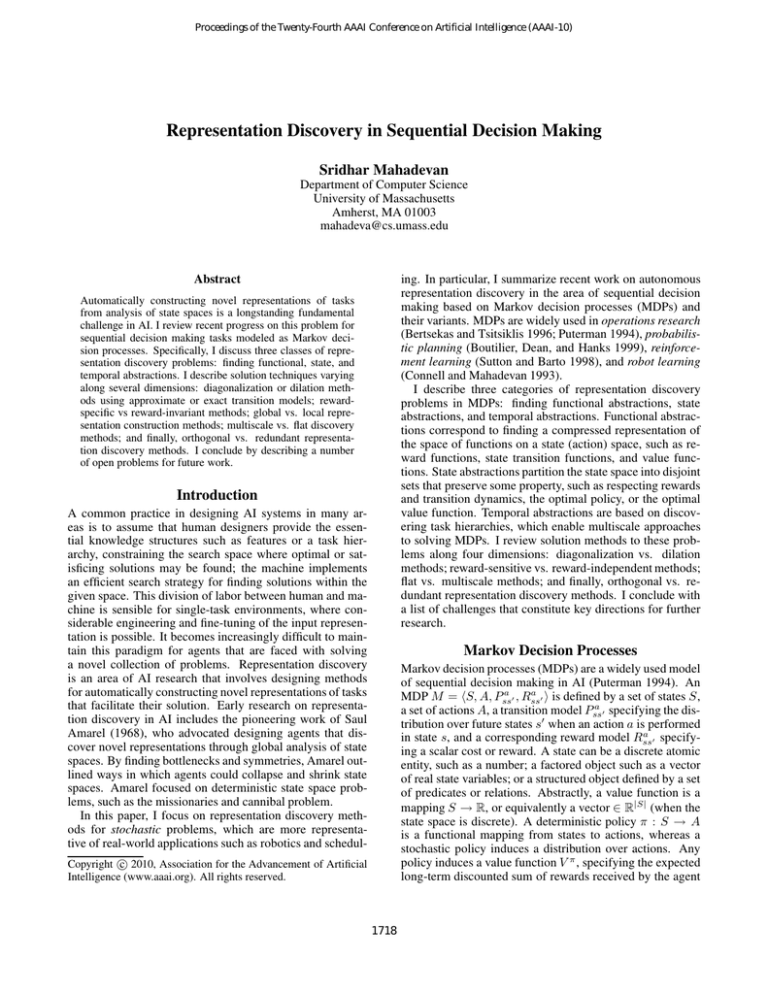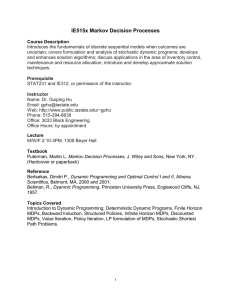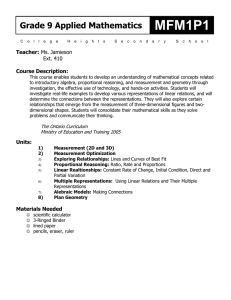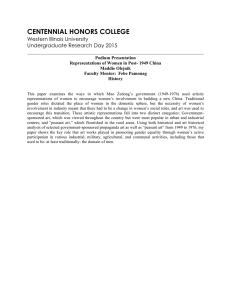
Proceedings of the Twenty-Fourth AAAI Conference on Artificial Intelligence (AAAI-10)
Representation Discovery in Sequential Decision Making
Sridhar Mahadevan
Department of Computer Science
University of Massachusetts
Amherst, MA 01003
mahadeva@cs.umass.edu
Abstract
ing. In particular, I summarize recent work on autonomous
representation discovery in the area of sequential decision
making based on Markov decision processes (MDPs) and
their variants. MDPs are widely used in operations research
(Bertsekas and Tsitsiklis 1996; Puterman 1994), probabilistic planning (Boutilier, Dean, and Hanks 1999), reinforcement learning (Sutton and Barto 1998), and robot learning
(Connell and Mahadevan 1993).
I describe three categories of representation discovery
problems in MDPs: finding functional abstractions, state
abstractions, and temporal abstractions. Functional abstractions correspond to finding a compressed representation of
the space of functions on a state (action) space, such as reward functions, state transition functions, and value functions. State abstractions partition the state space into disjoint
sets that preserve some property, such as respecting rewards
and transition dynamics, the optimal policy, or the optimal
value function. Temporal abstractions are based on discovering task hierarchies, which enable multiscale approaches
to solving MDPs. I review solution methods to these problems along four dimensions: diagonalization vs. dilation
methods; reward-sensitive vs. reward-independent methods;
flat vs. multiscale methods; and finally, orthogonal vs. redundant representation discovery methods. I conclude with
a list of challenges that constitute key directions for further
research.
Automatically constructing novel representations of tasks
from analysis of state spaces is a longstanding fundamental
challenge in AI. I review recent progress on this problem for
sequential decision making tasks modeled as Markov decision processes. Specifically, I discuss three classes of representation discovery problems: finding functional, state, and
temporal abstractions. I describe solution techniques varying
along several dimensions: diagonalization or dilation methods using approximate or exact transition models; rewardspecific vs reward-invariant methods; global vs. local representation construction methods; multiscale vs. flat discovery
methods; and finally, orthogonal vs. redundant representation discovery methods. I conclude by describing a number
of open problems for future work.
Introduction
A common practice in designing AI systems in many areas is to assume that human designers provide the essential knowledge structures such as features or a task hierarchy, constraining the search space where optimal or satisficing solutions may be found; the machine implements
an efficient search strategy for finding solutions within the
given space. This division of labor between human and machine is sensible for single-task environments, where considerable engineering and fine-tuning of the input representation is possible. It becomes increasingly difficult to maintain this paradigm for agents that are faced with solving
a novel collection of problems. Representation discovery
is an area of AI research that involves designing methods
for automatically constructing novel representations of tasks
that facilitate their solution. Early research on representation discovery in AI includes the pioneering work of Saul
Amarel (1968), who advocated designing agents that discover novel representations through global analysis of state
spaces. By finding bottlenecks and symmetries, Amarel outlined ways in which agents could collapse and shrink state
spaces. Amarel focused on deterministic state space problems, such as the missionaries and cannibal problem.
In this paper, I focus on representation discovery methods for stochastic problems, which are more representative of real-world applications such as robotics and schedul-
Markov Decision Processes
Markov decision processes (MDPs) are a widely used model
of sequential decision making in AI (Puterman 1994). An
a
a
MDP M = hS, A, Pss
′ , Rss′ i is defined by a set of states S,
a
a set of actions A, a transition model Pss
′ specifying the dis′
tribution over future states s when an action a is performed
a
in state s, and a corresponding reward model Rss
′ specifying a scalar cost or reward. A state can be a discrete atomic
entity, such as a number; a factored object such as a vector
of real state variables; or a structured object defined by a set
of predicates or relations. Abstractly, a value function is a
mapping S → R, or equivalently a vector ∈ R|S| (when the
state space is discrete). A deterministic policy π : S → A
is a functional mapping from states to actions, whereas a
stochastic policy induces a distribution over actions. Any
policy induces a value function V π , specifying the expected
long-term discounted sum of rewards received by the agent
c 2010, Association for the Advancement of Artificial
Copyright Intelligence (www.aaai.org). All rights reserved.
1718
in any given state s when actions are chosen using the policy. Any optimal policy π ∗ defines the same unique optimal
value function V ∗ , which satisfies the Bellman equation:
X
∗
a
a
∗ ′
V (s) = max
Pss
′ (Rss′ + γV (s )) .
a
as Bellman error basis functions (BEBFs) (Keller, Mannor,
and Precup 2006; Parr et al. 2007) and Drazin bases (Mahadevan 2009) vs. reward-invariant bases such as protovalue functions (PVFs) (Mahadevan and Maggioni 2007)
and geodesic Gaussian kernels (Sugiyama et al. 2008).
Reward-invariant methods exploit the intuition that value
functions are generally smooth functions on the state space,
and can be represented sparsely using a small set of carefully constructed bases. Reward-sensitive methods construct
bases that exploit specific knowledge of the task, and usually
the policy as well.
s′
Classical techniques for solving MDPs include value iteration and policy iteration (Puterman 1994). In small MDPs, it
is possible to store value functions exactly as a table. Larger
problems require the use of a function approximator to generalize estimated values across the state space. Temporaldifference learning (TD) (Sutton and Barto 1998) has been
shown to be an effective sampling-based method for solving large MDPs, when combined with a suitable function
approximator. Nonlinear approximation methods such as
neural nets have led to significant empirical successes with
TD (Tesauro 1992), but suffer from convergence problems
(Bertsekas and Tsitsiklis 1996). More recent methods, such
as least-squares policy iteration (Lagoudakis and Parr 2003)
and linear programming (Guestrin et al. 2003), are based
on a linear function approximation architecture using a set
of k ≪ |S| handcoded basis functions {φ1 , . . . , φk }, such
as orthogonal polynomials (Lagoudakis and Parr 2003) and
radial basis functions (RBFs). Hierarchical RL methods
are based on semi-MDPs (SMDPs), which allow temporally extended actions like “exiting a room” or “driving
home”, which correspond to executing a hierarchical policy over a portion of the state space (Barto and Mahadevan 2003). The MDP framework has also been extended
to richer state descriptions using first-order representations
(FOMDPs) (Boutilier, Reiter, and Price 2001). Partially observable MDPs (or POMDPs) address the problem of acting
when the underlying state is hidden (Kaelbling, Littman, and
Cassandra 1998).
State Abstraction
State abstraction methods induce a discrete mapping by partitioning the state (action) space into equivalence classes on
which the value function assumes a constant value. State
partitioning methods can be viewed as a special case of
functional abstraction defined by a basis matrix Φ of size
|S| by k, where the embedding of a state φ(s) ∈ Rk is
a binary row vector with exactly a single 1 indicating the
unique partition containing the state. Two states s and s′ are
considered equivalent by a state abstraction method if and
only if φ(s) = φ(s′ ). The set of all state abstraction methods forms a partially ordered hierarchy, which can be organized into a lattice structure (Li, Walsh, and Littman 2006),
based on the coarseness of the induced partition. Partitioning methods can be categorized into several classes: those
that are model-preserving in that they respect the reward
function and the transition dynamics (Givan and Dean 1997;
Ravindran and Barto 2003); those that preserve the (action)
value function for all (or only optimal) policies; and finally,
those that preserve the optimal action. Pattern databases
in deterministic search problems can be viewed as a special type of additive state abstraction that yield admissible
heuristics (Yang et al. 2008). A linear programming based
approach to learning admissible heuristics by feature discovery is described in (Petrik and Zilberstein 2008).
Representation Discovery Problems
I discuss three representation discovery problems in MDPs:
finding functional abstractions, state space abstractions, and
discovering temporal abstractions.
Temporal Abstraction
Finally, a third class of representation discovery methods for
MDPs is based on learning temporal abstractions. One approach is to learn an abstraction hierarchy over the set of
state variables, based on frequency of change (Hengst 2002),
or causal dependencies among state variables (Jonsson and
Barto 2005). Another approach is to learn reusable policy
fragments or skills, based on finding bottlenecks (Şimşek
and Barto 2004). Recent work on discovery of temporal hierarchies in POMDPs is based on nonlinear quadratic programming (Charlin, Poupart, and Shioda 2007).
Functional Abstraction
One general class of algorithms for constructing novel representations is to find task-dependent basis functions defined
on the state (action) space that span linear subspaces containing the optimal solution. This approach can be viewed
as compressing the space of all (value) functions f ∈ R|S|
into those that can be represented as a linear combination of
basis functions
X
f=
wi φi
i∈I
Representation Discovery Algorithms
where I is a set of indices specifying the selected bases. The
set of basis functions can be grouped together to form a matrix Φ of size |S| by k, where each column corresponds to a
basis function φi , and k ≪ |S|. Each row of this matrix defines a set of features φ(s) ∈ Rk , which can be viewed as a
real-valued vector embedding of the original state. The main
idea here is to exploit problem-specific information in constructing basis functions. Two general approaches to constructing basis functions include reward-sensitive bases such
In this section, I categorize algorithms for representation discovery into four categories: whether representations are constructed by dilation or diagonalization; whether representations are reward-sensitive or reward-independent; whether
flat or multiscale representations are constructed; and finally,
whether a minimal or overcomplete set of representations is
constructed. These categories not intended to be exhaustive,
however, but rather reflect recent work in the field.
1719
Dilation vs. Diagonalization Methods
Orthogonal vs. Redundant Representations
A general strategy for constructing representations is based
on diagonalization or dilation of an exact or approximate
transition model. Krylov methods (Petrik 2007; Poupart and
Boutilier 2003) are based on dilating the reward function
using powers of the transition matrix P π . The Krylov space
is the smallest subspace invariant under the reward function
Rπ and transition matrix P π , which can be constructed by
orthogonalizing the vectors
{Rπ , P π Rπ , (P π )2 Rπ , . . . , (P π )n−1 Rπ }.
BEBF representations are an incremental variant of Krylov
bases, which use the (sampled) Bellman error as basis vectors. The concept of dilation can be generalized to first-order
MDPs, where it is referred to as the regression of a reward
function over a specific action (Boutilier, Reiter, and Price
2001).
Diagonalization methods are based on finding the eigenvectors φi of a transition matrix P π , where P π φi = λi φi .
Since the diagonalization of arbitrary transition matrices
may not yield real-valued or orthogonal eigenvectors, it is
often expedient to use a reversible approximation P̂ π , such
as the natural random walk on a state space graph induced
by the policy π, where two states i and j are connected by
an undirected edge if there exists some action a such that
a
a
Pi,j
> 0 or Pj,i
> 0 (Mahadevan and Maggioni 2007). In
this case, the reversible random walk stochastic matrix is
defined by P̂ π = D−1 W , where W is the induced connectivity matrix and D is a diagonal matrix of its row sums. It is
more tractable to use the spectrally similar symmetric “nor1
1
malized” Laplacian matrix L = I − D− 2 W D− 2 , an object
of much recent study in machine learning.
Representation discovery methods that construct orthogonal representations can be contrasted with those that construct redundant representations. Orthonormal bases, such
as proto-value functions, represent value functions (or reward functions) uniquely as a weighted linear combination
of basis elements, where the weighting is given by hV π , φi i,
the projection of V π onto the ith basis element:
X
Vπ =
hV π , φi iφi .
i∈I
Overcomplete basis representations, such as diffusion
wavelets, can represent a given value function in many different ways, in which case an additional regularization step
can be used to find a sparse representation (Johns and Mahadevan 2009; Kolter and Ng 2009).
Learning Representation and Control
One framework for combining the learning of representation
and control is called Representation Policy Iteration (RPI)
(Mahadevan and Maggioni 2007), where the outer loop finds
a functional abstraction based on a specific policy (or reward function), and the inner policy evaluation loop finds
the closest (least-squares regularized) approximation within
the span of the constructed bases. An alternative approach
is to construct representations during the control learning
phase itself (Parr et al. 2007). The space of such hybrid representation-and-control learning architectures needs
to be explored further.
Reward-Specific vs. Reward-Invariant Approaches
Challenges
Reward-respecting state abstraction methods consider two
states s and s′ equivalent (or φ(s) = φ(s′ )) if and only if
R(s, a) = R(s′ , a) under each action a. Similarly, rewardsensitive basis construction methods, like Krylov bases,
use knowledge of the reward function to find representations of subspaces that contain the (approximately) optimal
value function. Reward-invariant approaches, such as PVFs
or geodesic Gaussian kernels, construct basis functions
reusable across multiple reward functions on the same state
(action) space. Petrik (Petrik 2007) proposed combining
reward-specific Krylov bases with reward-invariant protovalue functions as a way of integrating localized rewardspecific and more global eigenvector representations.
One significant challenge is how to scale representation discovery algorithms to high-dimensional problems. Some directions include low-rank matrix approximation (Johns, Mahadevan, and Wang 2007), exploiting pre-defined task hierarchies (Osentoski and Mahadevan 2010), and using relational representations (Wu and Givan 2007). The scalability of these methods to much larger discrete MDPs,
such as Tetris (Bertsekas and Tsitsiklis 1996) or backgammon (Tesauro 1992), and continuous state and action MDPs,
such as helicopter control (Ng et al. 2004), needs to
be explored further. Much of the work on representation discovery has been in fully observable MDPs. Research on constructing novel representations in POMDPs
is ongoing (Poupart and Boutilier 2003; Li et al. 2007;
Charlin, Poupart, and Shioda 2007). Finally, constructing
representations that transfer across tasks remains an important challenge (Taylor, Kuhlmann, and Stone 2008).
Flat vs. Multiscale Methods
Multiscale methods construct a variable resolution spatial
or temporal abstraction hierarchy. One approach uses a
hierarchical matrix approximation method called diffusion
wavelets (Coifman and Maggioni 2006), which constructs a
sparse representation of dyadic powers of a transition matrix. Similarly, Hengst (Hengst 2002) constructs a multiscale state hierarchy by partitioning the state variables based
on their frequency of change. In contrast, flat methods construct a single-level abstraction, such as eigenvector methods
like proto-value functions, or Krylov bases.
Acknowledgements
This research was supported in part by the National Science Foundation under grants NSF IIS-0534999 and NSF
IIS-0803288. I thank Jeff Johns, George Konidaris, and the
anonoymous reviewers for their feedback on this paper.
1720
References
Li, L.; Walsh, T.; and Littman, M. 2006. Towards a unified theory
of state abstraction for MDPs. In In Proceedings of the Ninth International Symposium on Artificial Intelligence and Mathematics,
531–539.
Mahadevan, S., and Maggioni, M. 2007. Proto-Value Functions:
A Laplacian Framework for Learning Representation and Control
in Markov Decision Processes. Journal of Machine Learning Research 8:2169–2231.
Mahadevan, S. 2009. Learning Representation and Control in
Markov Decision Processes: New Frontiers. Foundations and
Trends in Machine Learning 1(4):403–565.
Ng, A.; Kim, H.; Jordan, M.; and Sastry, S. 2004. Autonomous helicopter flight via reinforcement learning. In Proceedings of Neural
Information Processing Systems.
Osentoski, S., and Mahadevan, S. 2010. Basis function construction in hierarchical reinforcement learning. In AAMAS ’10: Proceedings of the 9th international joint conference on Autonomous
agents and multiagent systems.
Parr, R.; Painter-Wakefiled, C.; Li, L.; and Littman, M. 2007.
Analyzing feature generation for value function approximation. In
Proceedings of the International Conference on Machine Learning
(ICML), 737–744.
Petrik, M., and Zilberstein, S. 2008. Learning heuristic functions
through approximate linear programming. In International Conference on Automated Planning and Scheduling (ICAPS, 248–255.
Petrik, M. 2007. An analysis of Laplacian methods for value function approximation in MDPs. In Proceedings of the International
Joint Conference on Artificial Intelligence (IJCAI), 2574–2579.
Poupart, P., and Boutilier, C. 2003. Value directed compression
of POMDPs. In Proceedings of the International Conference on
Neural Information Processing Systems (NIPS).
Puterman, M. L. 1994. Markov Decision Processes. New York,
USA: Wiley Interscience.
Ravindran, B., and Barto, A. 2003. SMDP homomorphisms: An
algebraic approach to abstraction in Semi-Markov Decision Processes. In Proceedings of the 18th International Joint Conference
on Artificial Intelligence.
Şimşek, O., and Barto, A. 2004. Using relative novelty to identify
useful temporal abstractions in reinforcement learning. In ICML
’04: Proceedings of the twenty-first international conference on
Machine learning. New York, NY, USA: ACM.
Sugiyama, M.; Hachiya, H.; Towell, C.; and Vijayakumar, S. 2008.
Geodesic gaussian kernels for value function approximation. Autonomous Robots 25:287–304.
Sutton, R., and Barto, A. G. 1998. An Introduction to Reinforcement Learning. MIT Press.
Taylor, M. E.; Kuhlmann, G.; and Stone, P. 2008. Autonomous
transfer for reinforcement learning. In AAMAS ’08: Proceedings
of the 7th international joint conference on Autonomous agents and
multiagent systems, 283–290.
Tesauro, G. 1992. Practical issues in temporal difference learning.
Machine Learning 8:257–278.
Wu, J.-H., and Givan, R. 2007. Discovering relational domain
features for probabilistic planning. In ICAPS, 344–351.
Yang, F.; Culberson, J.; Holte, R.; Zahavi, U.; and Felner, A. 2008.
A general theory of additive state space abstractions. J. Artif. Int.
Res. 32(1):631–662.
Amarel, S. 1968. On representations of problems of reasoning
about actions. In Michie, D., ed., Machine Intelligence 3, volume 3,
131–171. Elsevier/North-Holland.
Barto, A., and Mahadevan, S. 2003. Recent advances in hierarchical reinforcement learning. Discrete Event Systems Journal
13:41–77.
Bertsekas, D., and Tsitsiklis, J. 1996. Neuro-Dynamic Programming. Belmont, Massachusetts: Athena Scientific.
Boutilier, C.; Dean, T.; and Hanks, S. 1999. Decision-theoretic
planning: Structural assumptions and computational leverage.
Journal of Artificial Intelligence Research 11:1–94.
Boutilier, C.; Reiter, R.; and Price, B. 2001. Symbolic dynamic
programming for first-order MDPs. In IJCAI’01: Proceedings of
the 17th international joint conference on Artificial intelligence,
690–697. Morgan Kaufmann Publishers Inc.
Charlin, L.; Poupart, P.; and Shioda, R. 2007. Automated hierarchy
discovery for planning in partially observable environments. In
Schölkopf, B.; Platt, J.; and Hofmann, T., eds., Advances in Neural
Information Processing Systems 19, 225–232.
Coifman, R., and Maggioni, M. 2006. Diffusion wavelets. Applied
and Computational Harmonic Analysis 21(1):53–94.
Connell, J., and Mahadevan, S. 1993. Robot Learning. Kluwer
Academic Press.
Givan, R., and Dean, T. 1997. Model Minimization in Markov
Decision Processes. In Proceedings of the AAAI.
Guestrin, C.; Koller, D.; Parr, R.; and Venkataraman, S. 2003.
Efficient solution algorithms for factored MDPs. Journal of AI
Research 19:399–468.
Hengst, B. 2002. Discovering hierarchy in reinforcement learning
with HEXQ. In ICML, 243–250.
Johns, J., and Mahadevan, S. 2009. Sparse approximate policy
evaluation using graph-based basis functions. Technical Report
UM-CS-2009-41, Department of Computer Science, University of
Massachusetts Amherst.
Johns, J.; Mahadevan, S.; and Wang, C. 2007. Compact spectral bases for value function approximation using Kronecker factorization. In Proceedings of the National Conference on Artificial
Intelligence (AAAI).
Jonsson, A., and Barto, A. 2005. A causal approach to hierarchical
decomposition of factored MDPs. In Proceedings of the 22nd international conference on Machine learning, 401–408. New York,
NY, USA: ACM.
Kaelbling, L. P.; Littman, M. L.; and Cassandra, A. R. 1998. Planning and acting in partially observable stochastic domains. Artificial Intelligence 101:99–134.
Keller, P.; Mannor, S.; and Precup, D. 2006. Automatic basis
function construction for approximate dynamic programming and
reinforcement learning. In Proceedings of the 22nd International
Conference on Machine Learning (ICML), 449–456. MIT Press.
Kolter, J. Z., and Ng, A. Y. 2009. Regularization and feature selection in least-squares temporal difference learning. In ICML ’09:
Proceedings of the 26th Annual International Conference on Machine Learning, 521–528.
Lagoudakis, M., and Parr, R. 2003. Least-squares policy iteration.
Journal of Machine Learning Research 4:1107–1149.
Li, X.; Cheung, W. K. W.; Liu, J.; and Wu, Z. 2007. A novel
orthogonal NMF-based belief compression for POMDPs. In Proceedings of the 24th international conference on Machine learning,
537–544.
1721







